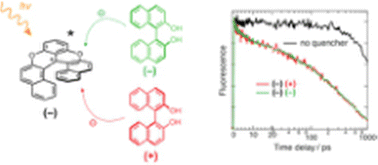Publication 236
- Looking for chiral recognition in photoinduced bimolecular electron transfer using ultrafast spectroscopy
Pragya Verma, Christoph Nançoz, Johann Bosson, Géraldine M. Labrador, Jérôme Lacour, Eric Vauthey
Phys. Chem. Chem. Phys. 2023, 25, 11111-11120

Occurrence of chiral recognition in bimolecular photoinduced electron transfer (ET) is difficult toidentify because of the predominant role of diffusion. To circumvent this problem, we apply a combi-nation of ultrafast time-resolved fluorescence and transient electronic absorption to look for stereo-selectivity in the initial, static stage of ET quenching, where diffusion is not relevant. The fluorophoreand electron acceptor is a cationic hexahelicene, whereas the quencher has either stereocentered(tryptophan) or axial (binaphthol) chirality. We found that, in all cases, the quenching dynamics are thesame, within the limit of error, for different diastereomeric pairs in polar and medium-polar solvents.The same absence of chiral effect is observed for the recombination of the radical pair, which resultsfrom the quenching. Molecular dynamics simulations suggest that the distribution of inter-reactantdistance is independent of the chirality of the acceptor and the donor. Close contact resulting in largeelectronic coupling is predicted to be possible with all diastereomeric pairs. In this case, ET is anadiabatic process, whose dynamics do no longer depend on the coupling, but are rather controlled byhigh-frequency intramolecular modes.
DOI : 10.1039/d3cp00760j
archive ouverte unige:168393
